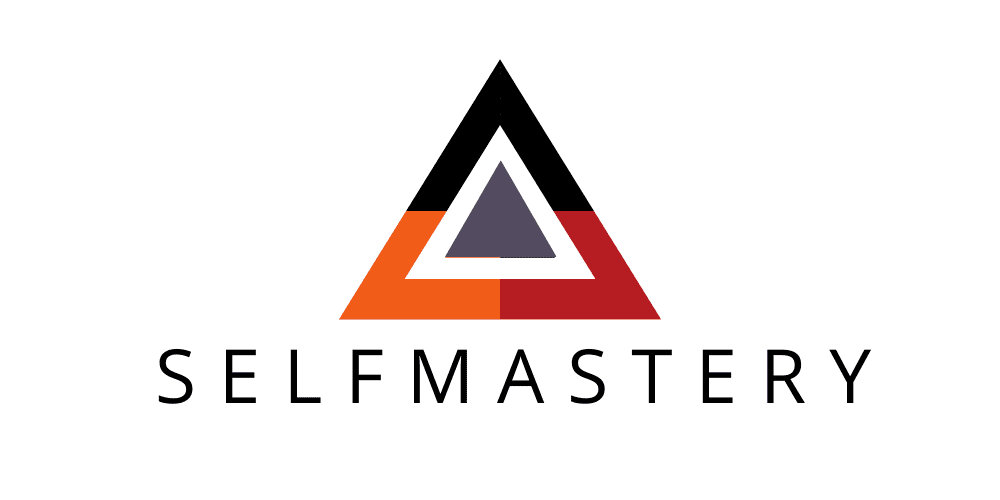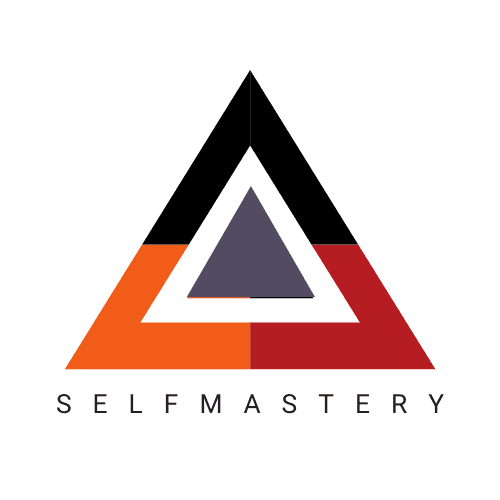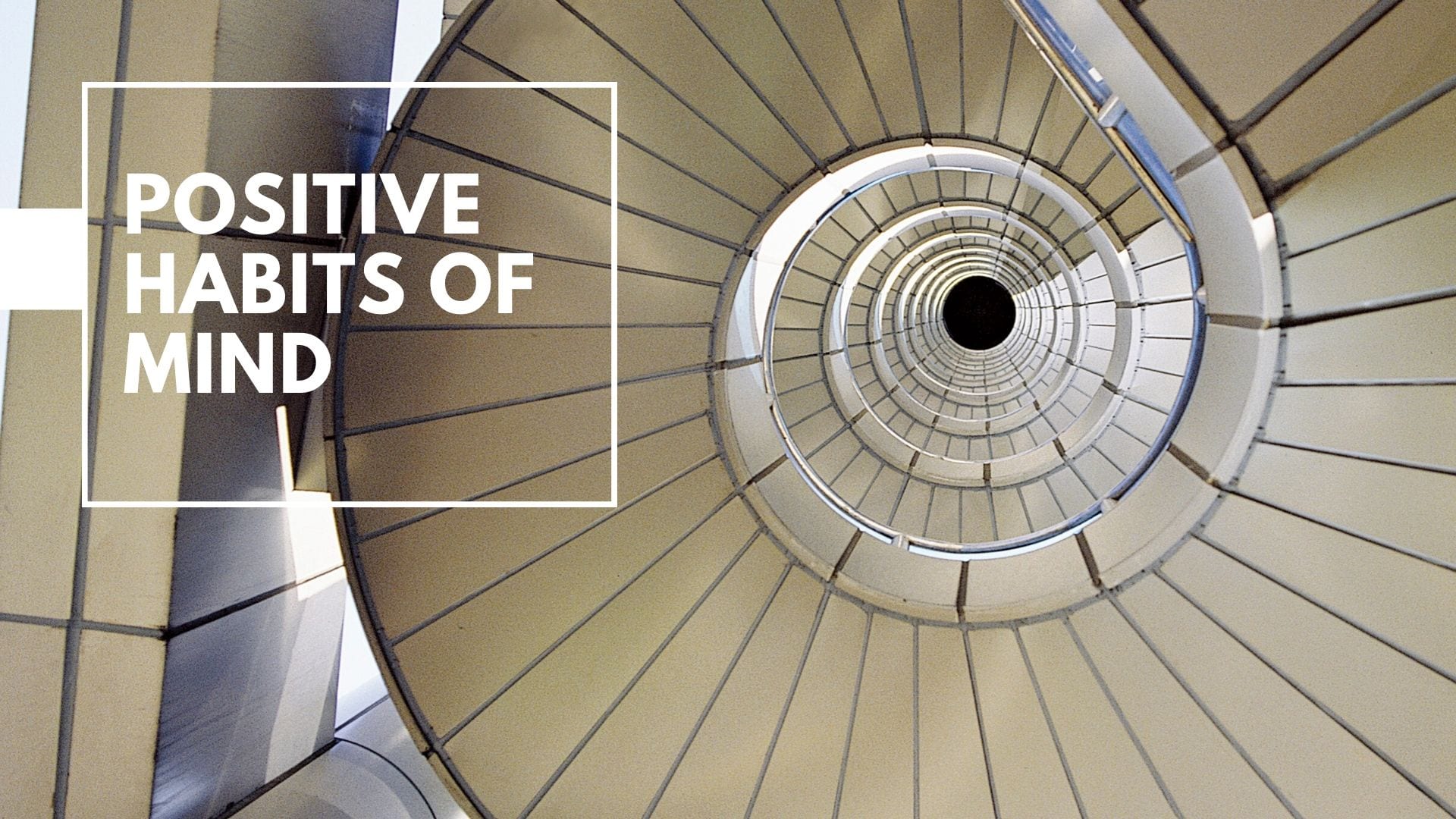
16 Apr Positive Habits of Mind
I love Francine, she always gives it to me straight. If she were Colombian she would have been from Santander. My family is from that region and I can tell you this, we speak our minds. We make a killer arepa, and if you ask us what we really think we will tell you, in a nice way, but with no embellishments. I like to think it is the subconscious belief that truth is the ultimate form of mercy. But Francine is not from Santander. She had a long day yesterday and today she just wants to get to “the peanut if the thing, Juan. Like you say, by the way, where did you get that from? It is ridiculous!” Francine likes me but she also thinks I talk too much. She looks at me in the eye and asks me: “Juan, carbs or no carbs. And don’t give me the “it depends” BS. Just tell me what you think. You have five minutes, go!”
I know better. “Francine, five minutes is not enough.” She looks at me with eyes that say “this is exactly the BS, I was talking about.” So we spend the next five minutes talking about how carbs are a broad category. Think of them as pick-up trucks. Some people need an F150, some people need a monster truck, and some people really do not need a pick-up truck. And that the real deal is to find a car that fully satisfies you. She is content, and because I talk too much, I start explaining to her that in nutrition, fitness, and mndset we are always confronting false dichotomies. I explain that it is just a habit of the mind that is culturally ingrained: it’s a bad case of splitting or “all or nothing” thinking. Francine is not having it: “see Juan, now you are going to write me a post.Just tell me what to do man!” But then we have to work out and the carbs conversation gets postponed.
Francine is right, I wanted to write her a post …this one. She got me thinking about Mindset and about being specific about what to do. I love those two topics, so here we go!
Habits of Mind Definition
You see, Mindset is one of those concepts that has become very popular and because of that, it has lost specificity. It is often vague. On top of that, our ideas around it come from academia, especially from the Psychology departments -although not exclusively. This means that we often look at it from one of two points of view 1) a very superficial one; or 2) a pathological one. The first case is represented in the average daily use. When a person says mindset most of the time they just mean attitude. When Henrick tells me: “Juan I went to that meeting with the right mindset, I was ready to crush it.” That’s not a mindset, it is an attitude. The second case means that we have become very good at identifying mindsets that are unproductive. We have identified general trends and their negative consequences. In other words, we are better at understanding the commonalities among the mindsets of people with poor ones, than among those who have good ones. All together, this means that when it comes to Mindset we need a little bit of a Francine attitude in the world. We need to be positive and specific. Just tell people what to do! This post is for you Francine. Let’s do this.
First, let’s define the thing we are talking about. A mindset is a set of ideas or assumptions that mediate our behaviors. Now in order to separate this from the vague term “attitude”, we have to delimit this set of ideas. A mindset is formed by ideas that we use to define our sense of self in a deep way. For example, Henrick considers himself very funny. He also thinks of himself as a peace-maker, he knows how to defuse tension by bringing people back to a common objective. These ideas help Henrick define himself. In a presentation at work, one of his points generates a heated debate among the audience. Thanks to these self-beliefs he can keep calm, cool and collected. His Mindset mediates his behavior and response,so he can dissipate the heat and continue with the presentation he is ready to crush. And so he does.
Mindsets are created throughout our lives, they are based on our experience of reality. Moreover, they are determined by how we interpret reality ;these interpretations are the foundation of our Mindsets. As I have said, we have mostly studied people that have negative mindsets, therefore we have identified the common ways in which people with poor mindsets interpret reality. These ways are what we call bad habits of mind and I have described few of them here. What I want to do now is present you with some good habits of mind. These habits are based on my professional experience with my clients. They don’t aim to be absolute or complete, but they do aim to be helpful and applicable.
Healthy Habits of Mind
▶ Find continuum. Splitting (all or nothing) is not always evident. Most of the time it is implicit. Most of my clients ask me for the proper way to do squats, the best whey protein, the right intensity for a workout. None of this looks like an All or Nothing. But it is in our minds, because we make the ideal Option A, and we make everything else Option B. We just divided the universe into two sets. The problem is that we can always do that, and we often do. It is how Hollywood sells us love, there is the love of your life: Option A, and then there is everything else which will never be as good , Option B. There is really no logic mistake here, it is just an unproductive way to see the world. The solution is to always be looking for continuua. A continuum is still a model, right? It is still a simplification of the world but it is much more productive. How it works is simple. When Henrick asks me: “Juan how should I know how hard to push in a given workout?” The first thing to do is to identify the underlying ideal assumption (what counts as Option A?). In this case, there is one right intensity. Option B is everything above or below. But the truth is that every workout below Option A, still counts, asdo the ones above. We actually live in Option B. There is nothing wrong with that, what we want is to be always trying to get to A. The cool thing is that the continuum also gives you a way to behave and gives you infinite good options. In this example what Henrick needs is to realize that the ideal intensity is the workout that produces the most adaptation with the least strain. This gives you a guideline for how to behave. Get enough intensity in your workouts and err on the side of too little strain rather than too much. That way, you will be always moving forward and never really wrong.
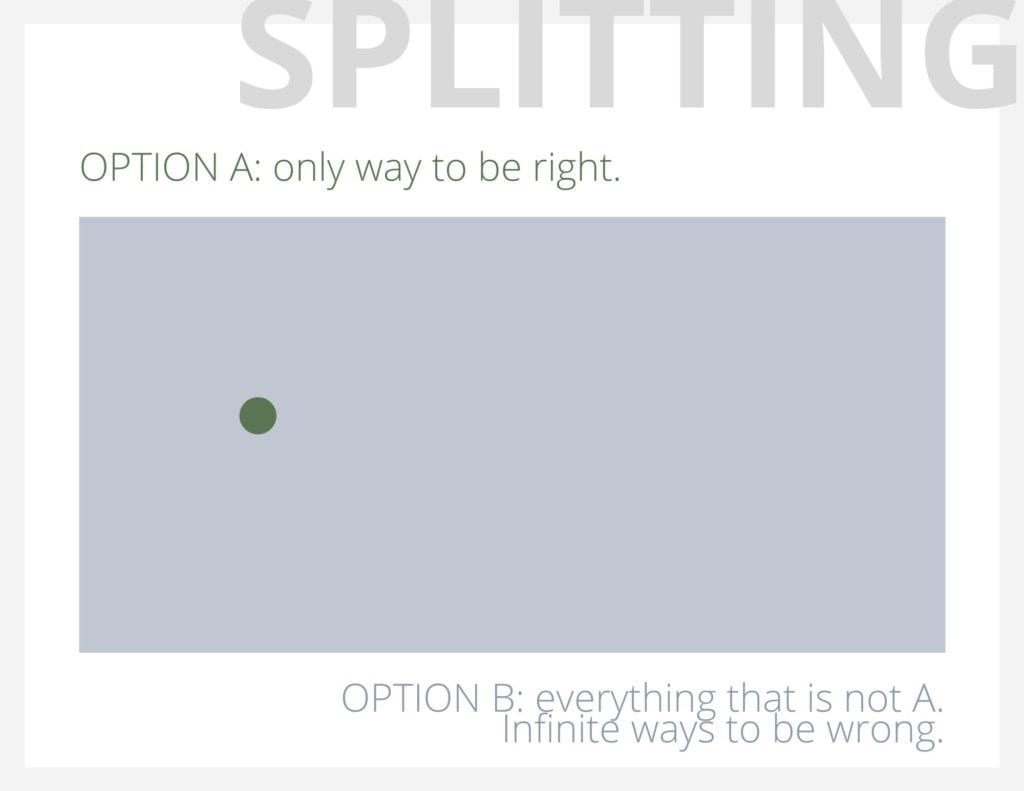
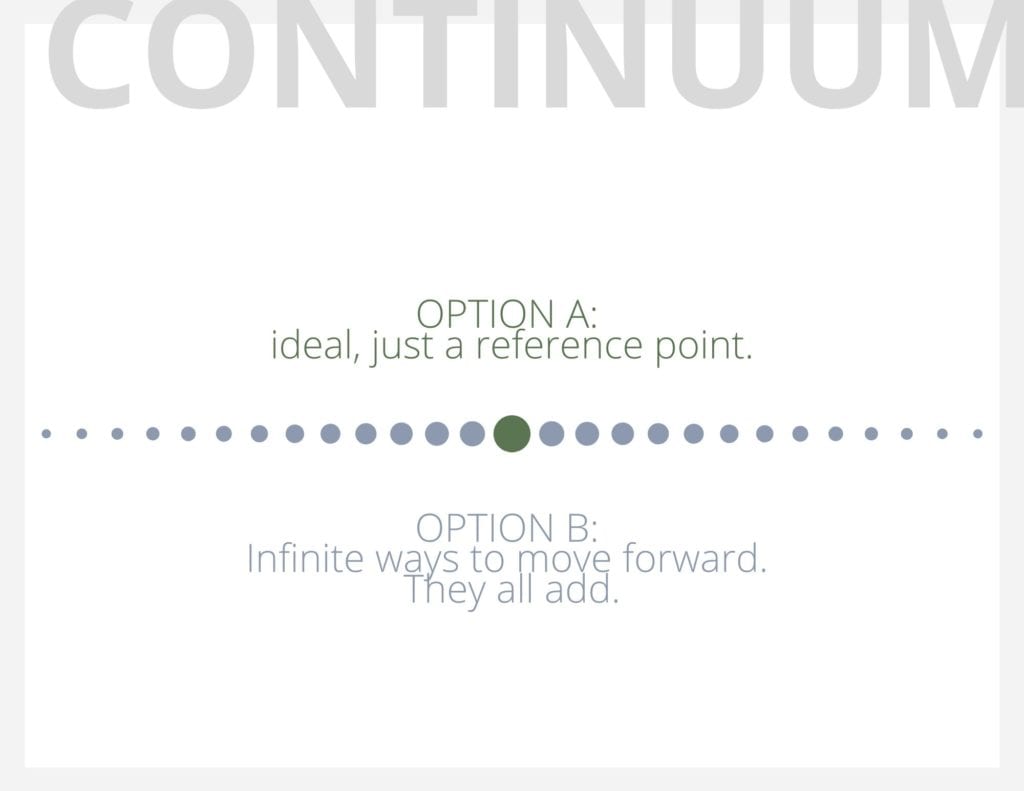
Keep in mind that the continuum we created for Henrick is just one way of many to create a continuum. If for example we were going to try to use this same idea for Francine’s carbs we would have a different continuum. One in which Option A is super nutritious slow-digesting carbs, and Option B is highly refined fast-digesting with little to no nutritional value carbs (think: pop tarts). In this case, the continuum allows us to always be trying to get to A, and put our energy in always moving towards better in that continuum.
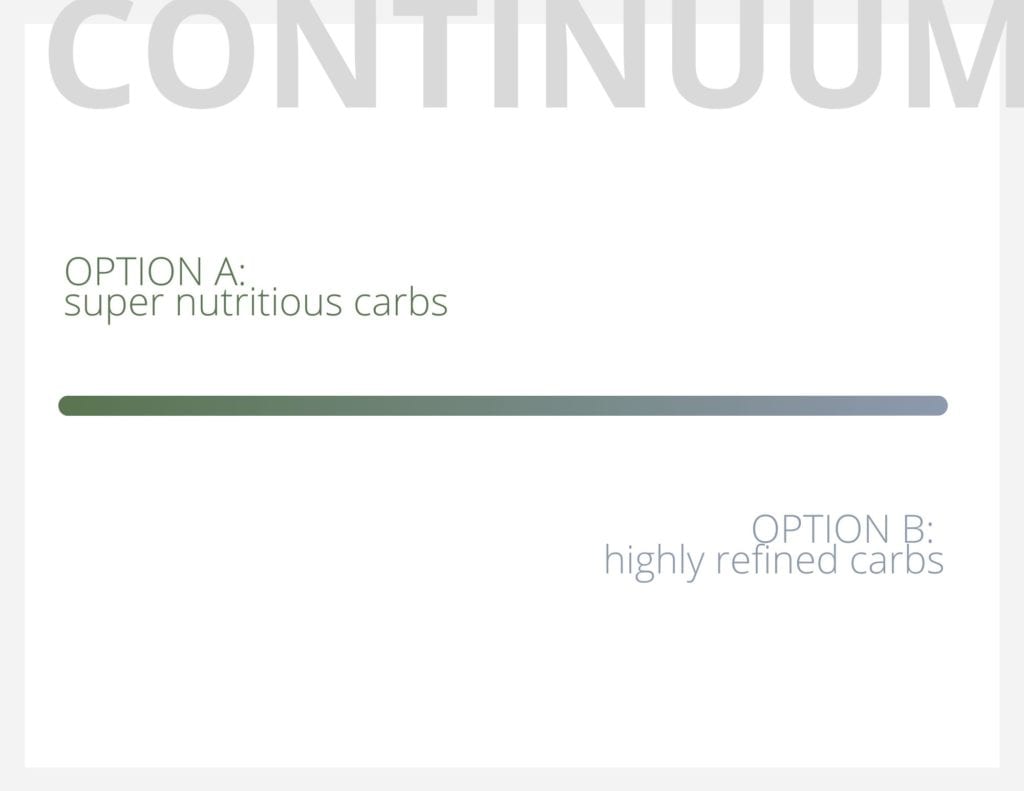
▶ Identify your biases. We don’t operate on facts. It would be awesome if we did but we don’t. We operate on the different ways our emotions have shaped our experiences. We are always biased. The most important thing is to accept our bias and always strive to be consciously biased. And this means being both intentional and aware. I know I will always push my clients towards the things that have worked for me. Paradoxically, accepting this helps me be more open to their ideas. I know my way is just my way and I can always explain my bias. Listening to their views helps me identify and understand their bias and hence understand them better. Do the following. Always check why an idea is convenient for you. Always check why a particular read on a situation benefits you, why does it appeal to you. You will find your biases there. I think gymnastics are the bomb! It is a discipline that rewards patient learners. It is a discipline that rewards learners who enjoy having an aesthetic attached to the thing they learn. It is a discipline that rewards ectomorphs. I am all those things. Naturally, I love gymnastics. Naturally, I want to push it to my clients. But I also know by looking at those biases that maybe gymnastics is not right for everybody, and that is key. Don’t strive to be unbiased, strive to be consciously biased.
▶ Opportunity is random, growth is a choice. Athletes will tell you: “sometimes you win, sometimes you learn”. The classic cheesy Instagram post will tell you that every crisis hides an opportunity. The idea of seeing the good in the bad is old and tired. Interestingly enough, although productive, these ideas reflect a splitting mindset. That’s not cool. They point in the right direction, though. Get this: what happens to you is always the most important thing, not the event itself. Specifically what you do with an event is everything. Analyzing your experiences from the point of view of your learning, of bettering yourself, is what makes you grow. You don’t need a crisis or a loss to apply this.
▶ Take full responsibility for your actions and only yours. We all try to do this at some level. It is called being an adult. But it is difficult. I think there is an easy rule of thumb. If there is a hero, a villain or a helpless soul in your story then there is an imbalance in the way you are allocating responsibility. When I was a college teacher, my colleagues and I would get annoyed at things that the students would do. “I have explained that three times, why can’t they get it?” “I told them in all ways possible this was a hard deadline! Why are they now asking me for an extension?” The problem was that the question was always rhetorical. We were never trying to answer it. We were always victims of their incompetence, and they were lazy or disorganized idiots. There was a misallocation of responsibility. The fact we did not really explore why these things were happening for our students shows you that we weren’t fully taking responsibility for our side. The fact that we were so annoyed at them shows you we were taking on too much responsibility for their actions. It took me some years of teaching to understand how important this balance was for the learning process. If I took responsibility for the success of the student, I would be disempowering my students from their own behaviors. I learned to make sure I did everything to meet my students where they were, understand what they needed, and give it to them, but always respecting their agency. It is a lot harder than it sounds, but it helps people learn both sides. (Easy heuristic: if there is a victim in your story, you might need to check the balance of responsibility).
There you go, Francine. Those are positive habits of mind that foster productive mindsets. Try to engrain these habits in yourself and you will start seeing your mindsets change. It is hard because the world of absolutes, heroes, villains, and victims is so much easier to digest, which is why Hollywood relies on it. But that’s just the movies; life is richer, more complex and it is there to be experienced in all its dimensions.
THRIVE!
